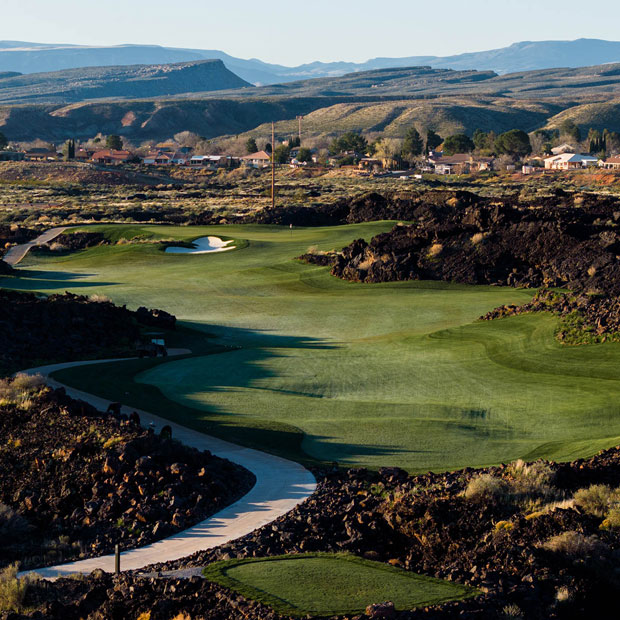Bel-Air Country Club
Bel-Air is George Thomas and Billy Bell’s most impressive feat of construction, a sporting course carved out of a series of severe Los Angeles canyons

Los Angeles, California, USA
George Thomas (original design, 1927); Dick Wilson (renovation, 1962); Robert Trent Jones (renovation, 1974); Tom Fazio (renovation); Renaissance Golf Design (restoration, 2018)
Private
On the Skillet: No. 2 at Bel-Air
The Latest from the Rollback Wars and the Excellence of Bel-Air CC with Geoff Shackelford
Housing-development golf has gotten a bad name in California recently, and for good reason. We shouldn't forget, however, that some of the greatest Golden Age courses in the state started out as real-estate ventures. Bel-Air Country Club, nestled in the canyons above the University of California, Los Angeles campus, is a good example. In the mid-1920s, oil magnate Alphonzo Bell founded the club as part of Bel Air Estates, an upscale residential community catering to the film industry’s elite. Bell hired George Thomas to design the course, and Thomas’s associates Billy Bell (no relation to Alphonzo) and Jack Neville assisted on the project. Completing Bel-Air required audacious feats of engineering, including building a swinging bridge, an elevator, and multiple tunnels. When it opened in 1927, the course was Thomas’s first L.A. masterpiece, soon to be joined by Riviera Country Club (1927) and the renovated North Course at Los Angeles Country Club (1928). This trio still stands as perhaps the greatest single-city showcase of one golf architect’s mastery. In the decades after World War II, Dick Wilson, Robert Trent Jones, and Tom Fazio made changes to the course, but Tom Doak undid much of their work in his 2018 restoration.
{{content-block-course-profile-bel-air-country-club-001}}
Take Note…
Always tell the press exactly what’s on your mind. In a 2015 interview with Ran Morrissett, Tom Doak impulsively told the truth when Morrissett asked him which courses would most benefit from restorations. Doak would later say that he normally demurs on this topic; he’d rather not make enemies of the current consulting architects. In this case, however, he called out two clubs: Dornick Hills, a Perry Maxwell design in Oklahoma, and Bel-Air. His answer found its way to Bel-Air’s green committee, which promptly invited him to visit. Doak’s firm also finished a restoration at Dornick Hills last year. The moral of the story: spilling the beans to nosy journalists is a wise career move.
Dig it out of the dirt. Doak’s Renaissance Golf Design team discovered the dimensions of several bunkers at Bel-Air simply by digging down and finding old bunker sand. It seems that the certain mid-20th-century construction crews had, in some instances, just built on top of Thomas and Bell’s features instead of stripping them away first. Thank goodness for their laziness.
Appointment viewing. The 2023 U.S. Women’s Amateur will take place at Bel-Air Country Club August 7-13. Set your TiVos accordingly (people still have TiVos, right?). And if you live in the L.A. area, go to at least a day of the tournament. The U.S. Women’s Am is one of the best in-person viewing experiences in the game.
The Idol. Speaking of TiVo, this new HBO series starring Lily Rose-Depp and The Weeknd was partly shot at The Weeknd’s house, not far from Bel-Air’s 11th tee. Fried Egg staffer Cameron Hurdus says The Idol is his favorite show of all time, surpassing even Breaking Bad and The Sopranos. (Note: he does not say that.)
Favorite Hole
No. 9, par 4, 310-410 yards
The ninth hole at Bel-Air may seem like an odd choice for a favorite, given that the chasm-crossing 10th and the “Mae West” 12th are far more dramatic, but this short par 4 exemplifies the cleverness of George Thomas’s architecture. In a setting that provided little natural room for strategic golf—a narrow canyon just below the clubhouse—Thomas created several distinct options for play.
Favorite Hole
No. 9, par 4, 310-410 yards
The ninth hole at Bel-Air may seem like an odd choice for a favorite, given that the chasm-crossing 10th and the “Mae West” 12th are far more dramatic, but this short par 4 exemplifies the cleverness of George Thomas’s architecture. In a setting that provided little natural room for strategic golf—a narrow canyon just below the clubhouse—Thomas created several distinct options for play.
A small barranca, restored by Tom Doak’s crew, runs along the left side of the fairway before crossing diagonally in front of the shallow, angled green. The most aggressive play is to a strip of short grass on the other side of the barranca. If you lay up, you can either aim the most visible section of fairway on the left, where you’ll have a good angle into the green, or seek a shorter approach by launching your tee shot over the shoulder of a hill on the right. You can play this hole many times and never be fully confident that you’ve figured out the “right” strategy.
Plus, after you putt out, you get to walk through a tunnel and ride an elevator up to the 10th tee, which is freaking cool.

{{content-block-course-profile-bel-air-country-club-002}}
Overall Thoughts
As a feat of routing, Bel-Air may not have an equal in American golf. The topography is so abrupt, the golfable terrain so compact, and the property so disjointed that only a first-rate architect (not to mention a capable engineer) could have sculpted it into 18 sensible holes. George Thomas went on to design better courses, but he never demonstrated his creativity and panache more clearly.
At Bel-Air, Thomas faced something like the inverse of the problem Bill Coore and Ben Crenshaw had at Sand Hills 70 years later. Whereas Coore & Crenshaw needed to locate a single course within a web of a thousand wonderful possibilities, Thomas had to find and connect 18 holes on a piece of land that resisted golf at every turn. It was a puzzle with one solution.
When Alphonzo Bell hired Thomas, the routing task didn’t seem so difficult. The initial property included a flatter (though far from flat) section to the south, across what is now Sunset Boulevard. The course could wander down there and then travel back up the canyons to the hilltop clubhouse without enormous difficulty. Just before construction started, however, Bell delivered bad news. The more tractable land was no longer available; UCLA had claimed it and would later develop it into the heart of its campus, which today includes Pauley Pavilion, Drake Stadium, Royce Hall, and Powell Library.
Bel-Air Country Club was left with three steep canyons that wouldn’t accommodate more than 11 holes. However, having flown his sea plane through these hills many times, Thomas knew of another valley west of the site. It was narrow but long enough to complete the course. The main issue was access. How could you move golfers over the intervening terrain without a funicular?
Legend has it that one day Thomas and his associates Billy Bell and Jack Neville stood on the hill where the clubhouse and first tee would be built, looked across an arroyo to the ridge that blocked the way to the extra canyon, and decided to hit some balls. They discovered that a long par 3 could play from one hill to a saddle in the other. From that green, one could walk 100 yards to a tee that overlooked the neighboring valley. Granted, transporting players to and across the 10th hole would require a tunnel, an elevator, and a bridge, respectively, but it worked, and it made the back nine possible.

I love this story, even if some of the details aren’t 100% factual. But designing the Bel-Air routing took more than a single flash of inspiration—hey, boys, why don’t we play right across there! The property had several other troublesome transitions. For some of these, Thomas used par 3s as connectors, most spectacularly on No. 10 but also on Nos. 3, 5, and 16. The third hole is like a miniature, downhill version of the 10th, squeezing through a gap in a hill from one canyon to another. (In this case, Thomas appears to have availed himself of some dynamite.) The fifth and 16th holes each climb to a notch at the base of a hill so that the tunnel to the next tee can be as short as possible.
What’s most impressive about these par 3s is that they don’t feel like connectors. Each is distinct and striking rather than merely functional.
{{content-block-course-profile-bel-air-country-club-003}}
Another problem that called for a clever routing fix was that the additional valley Thomas discovered was almost too cramped to fit fairways traveling in both directions. To alleviate safety concerns, Thomas spaced out the landing zones on different holes. For example, the area where most drives land on the 11th hole is about halfway between where players tee off on the 15th hole and where most drives end up. On the parallel 12th and 14th holes, the landing zones are staggered, and the 12th green, in an underrated bit of construction, is benched sideways into the canyon wall, safely distant from the 14th fairway. While changing equipment and more frequent play have tested these solutions, they still more or less work as Thomas intended.

Hole for hole, Bel-Air doesn’t have the sustained greatness of Thomas’s later efforts at Riviera and L.A. North, but Tom Doak’s restoration brought back some strokes of brilliance that the club abandoned in the late 20th century. The course’s three bunkerless holes—Nos. 9, 10, and 12—stick in the memory because of the unusual green-side shaping that Doak’s team re-created. Also, the removal of gratuitous trees, bunkers, and ponds (yes, there were ponds, plural!) uncovered some of the original character of the land. So even if Bel-Air doesn’t quite reach the level of Riv and L.A., it once again deserves to be spoken of in the same breath.
That said, in some ways, Doak’s restoration didn’t—or couldn’t—go far enough. Houses and safety considerations appear to have been limiting factors. Take the 17th hole, which used to run along a big, open ledge. On the tee shot, you could bite off as much of the natural hazard as you dared to gain a shorter approach. Today, that option is blocked by trees, which were likely planted to protect the top-dollar mansions below. A necessity, perhaps, but a sad one: from the looks of it, Bel-Air’s original 17th was a stunner.

Other shortcomings of the restored course are harder to explain. The artificially powered brook that babbles through Nos. 11-15 is an eyesore and a far cry from the natural ditches that Thomas and Bell incorporated into almost all of their Southern California designs.
{{content-block-course-profile-bel-air-country-club-004}}
The bunkers are also a touch too refined to my eye. Although they mimic the capes and bays of the originals, they lack the ruggedness of Thomas and Bell’s peak late-1920s style. The result is an in-between look—faithful in dimension and shape but not in spirit. Maybe Bel-Air’s members were reluctant to follow, or be seen as following, a bunker-restoration strategy that a rival club made famous. In this case, though, I think they should have.
Still, of the three great L.A. clubs, Bel-Air seems to have the most positive momentum right now. Its superintendent, Justin DePippo, is young and smart, and its membership is vibrant and focused on fun and amateur golf rather than rankings and professional majors. I expect the prince of George Thomas’s portfolio to keep getting fresher. -GM
1 Egg
Bel-Air has significant strengths across all three of our categories—land, design, and presentation—but no obvious Egg for any one of them. The land is unique but awkward; the design is ingenious but incompletely restored; and the turf is firm and expertly manicured, but the course’s overall presentation is more Hollywood than Thomas. Let’s call it one Egg, with real potential to reach two.
Additional Content
On the Skillet: No. 2 at Bel-Air
Course Tour

{{content-block-course-profile-bel-air-country-club-005}}
Leave a comment or start a discussion
Get full access to exclusive benefits from Fried Egg Golf
- Member-only content
- Community discussions forums
- Member-only experiences and early access to events













Leave a comment or start a discussion
Lorem ipsum dolor sit amet, consectetur adipiscing elit. Suspendisse varius enim in eros elementum tristique. Duis cursus, mi quis viverra ornare, eros dolor interdum nulla, ut commodo diam libero vitae erat. Aenean faucibus nibh et justo cursus id rutrum lorem imperdiet. Nunc ut sem vitae risus tristique posuere. uis cursus, mi quis viverra ornare, eros dolor interdum nulla, ut commodo diam libero vitae erat. Aenean faucibus nibh et justo cursus id rutrum lorem imperdiet. Nunc ut sem vitae risus tristique posuere.